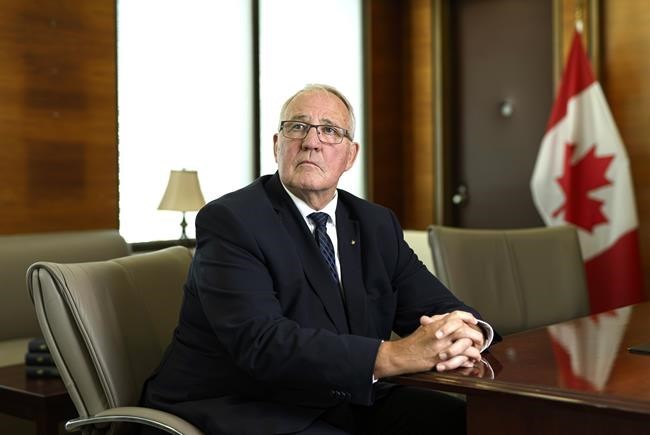OTTAWA — As he settles in to the corner office in Ottawa's National Defence headquarters, Bill Blair is feeling pretty comfortable in his new role.Â
This is his fourth ministerial job since 2018, when he was put in charge of border security and organized crime reduction. Blair has also overseen the departments of Public Safety and Emergency Preparedness -- roles where he's been in close contact with the military.Â
"I want to make sure that they have the support, the resources, the training, the equipment that they need in order to be there for Canadians," Blair said in an interview.
Anita Anand's departure as defence minister less than two years after she took over, pledging to change the military's culture and tackle the sexual misconduct crisis that had seen a slate of top generals removed from their positions, came as a surprise to many.Â
When the cabinet shuffle was announced, she and Blair both seemed prepared to respond to questions about the optics of replacing a woman of colour with a 69-year-old man. Â
"I have no doubt in my mind that he understands, given his experience, large organizations and how they work," Anand told reporters.
When he faced the media shortly after, Blair also touted his experience as chief of the Toronto Police Service from 2005 to 2015.Â
"We actually created the most diverse police service of any police service in Canada and one of the most diverse in North America," he said, adding that he has the experience of "working through a significant cultural change in a uniform organization."
That raised eyebrows among those who have been closely watching the military's reform efforts to date.Â
"Diversity doesn't mean culture change," said Charlotte Duval-Lantoine, a fellow at the Canadian Global Affairs Institute who wrote a book about toxic culture in the military.Â
"This is what we saw with women's integration in the 1990s, for example. Women were added to the military but their value and their contribution as women were not valued to the same extent ... and we're still reckoning with this problem today."
Toronto police are still reckoning with systemic racism. The Ontario Human Rights Commission found in a 2020 report that Black residents were more likely than white residents to be hurt or killed by police.Â
Almost 25 per cent of all Special Investigations Unit cases about a death, injury or alleged sexual assault by police involved Black people, the report found. Black people represented 32 per cent of charges in the data from 2013 to 2017, though they make up just shy of nine per cent of the population.Â
That issue was well-recognized when Blair was in charge.
Alok Mukherjee, police services board chair at the time, said there was a lot of positive change in his early years. The force hired the first hijab-wearing officer, for example.
"In spite of these efforts, the organization was still treating racialized people -- Black people particularly -- differently. That racial profiling had not gone away," Mukherjee said.Â
In response, he said, the police services board tried to bring in a "very strong" policy to deal with racial profiling and so-called carding. Blair resisted.
"Philosophically, I think he was on board and he did make some of his own efforts to deal with it, but he was not prepared to accept the kind of fundamental change that the board, having heard from the community, was directing him to implement," Mukherjee said.
"What I understood is that Mr. Blair can go only so far, but he has a respect for tradition. His favourite metaphor tended to be, 'You can rock the boat, but don't sink it.'"Â
Blair bristled at questions about that, saying he disagrees with Mukherjee.
"We fundamentally changed our our recruiting systems, our employment systems, our staffing and training and development systems to make sure that people would have every opportunity to be successful and feel supported," he said.
When pressed on the difference between improving diversity within the ranks and making transformative culture change, Blair said there was "never any tolerance of any systemic discrimination" when he was chief.
"Those more toxic elements, they're not really part of of the culture of the Canadian Armed Forces. They can permeate and affect the culture, but those are the things that we have to remove while we retain all that is excellent about that commitment to service."
Mukherjee said Blair will need to stand up to the military's top brass to make real change.
"These organizations, whether it is the military or the police, which is paramilitary, are very inbred and tradition-bound. They don't change the way they work easily," he said.Â
At the same time, the Armed Forces is facing other significant challenges. There's the personnel shortage. More than 16,000 positions are vacant, and the military is ramping up recruitment and overhauling basic training to address what it calls a crisis.Â
The government has committed to send more soldiers to Latvia as part of a NATO mission, growing Canada's presence to around 2,200 troops from 800 in coming years.
Aging equipment, a notoriously slow procurement process, and donations and purchases for the defence of Ukraine have combined to yield reports that soldiers are buying better gear off the shelf and that international allies are frustrated with Canada's lack of commitment to NATO spending targets.
On top of everything else, natural disasters have become increasingly common and the military is being called upon to deal with floods, fires and hurricanes from coast to coast to coast.Â
Duval-Lantoine and Mukherjee both say they wish Blair well in his new job.Â
"There's a lot of work to be done in terms of relationship and trust building," Duval-Lantoine said.Â
"It might sound counterintuitive: We require continuity and a certain stability in the way that culture change is being pursued."
This report by The Canadian Press was first published Aug. 5, 2023.
Sarah Ritchie, The Canadian Press




